
Contact us
Our team would love to hear from you.

In light of recent events, no doubt remains that traditional business models must be transformed for the growth and success of any business, including healthcare. A McKinsey survey showed that since the pandemic, C-level managers have felt a strong need to innovate their workflows. The question now is not whether digital transformation is necessary, but rather how to begin the process.
Read on to learn more about the nature of digital transformation, the opportunities it offers to healthcare, the obstacles that organizations face on the road to total digital transformation, and the strategies necessary to overcome these challenges.
Digital transformation is a full-scale process that involves integrating and applying advanced technologies to improve the performance of healthcare organizations and bring patient care to a new level. In other words, digital transformation is not about using software in a particular case but about holistic global and scale change. Indeed, it involves a complete transformation of the entire organization, including all processes, care delivery models, and corporate culture. Digital health transformation requires technological and cultural change in equal measure, as organizations must reconsider the principles that underpin the care delivery operations, patient experience, and benefits offered.
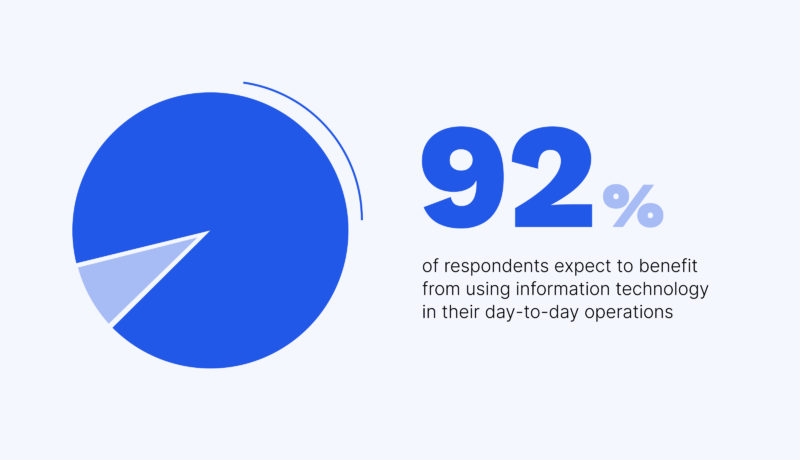
Key advantages and examples of digital transformation in healthcare
According to a Deloitte study, about 92% of respondents expect to benefit from using information technology in their day-to-day operations. This is not at all surprising, as advanced technology offers many advantages for healthcare in general and for patients and physicians in particular.
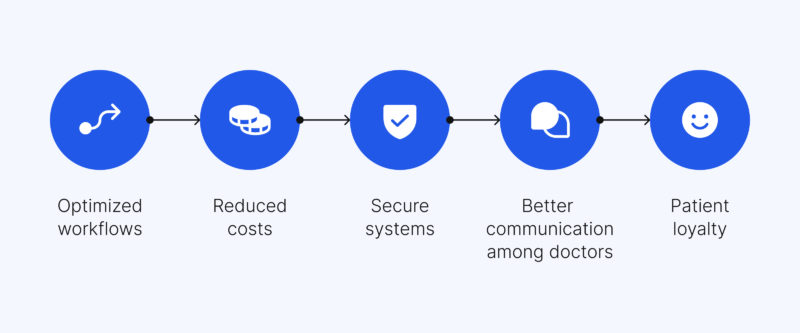
Digital transformation in the healthcare market and benefits for healthcare providers
Information technologies can dramatically improve the speed and quality of physicians’ work by removing routine tasks that are not related to their primary duty — treating patients. For example, EHR and EMR systems automate not only document management, but also other day-to-day processes (e.g., prescribing drugs, scheduling tests and receiving results, interacting with insurance companies, etc.). In addition, there are numerous tools that perform in-depth analysis of a patient’s medical history in order to recommend treatment plans to clinicians that may yield the best results.
Profitability is a core question for every business, including healthcare institutions. Advanced technologies can also be helpful in this regard. In particular, automating workflows allows healthcare organizations to provide more cost-effective services. Moreover, healthcare providers can save on equipment maintenance by using smart devices. This is possible due to IoT-embedded systems that can monitor the state of equipment and send alerts if they are malfunctioning.
When building healthcare software, engineers pay careful attention to data encryption and system protection. These processes are critically important, as mistakes are extremely costly. That’s why medical software development is regulated by a large body of strict rules. As a result, all healthcare systems must provide a high security level for sensitive information.
Using dedicated software (e.g., EHR), physicians can share information not only among colleagues within the same organization but also between different organizations. Hence, doctors can quickly transfer a patient’s history to a related specialist or organize a concilium.
Technology can build patients’ trust and confidence by providing personalized healthcare services, seamless access to medical information, convenient appointment scheduling, and the use of innovative techniques.
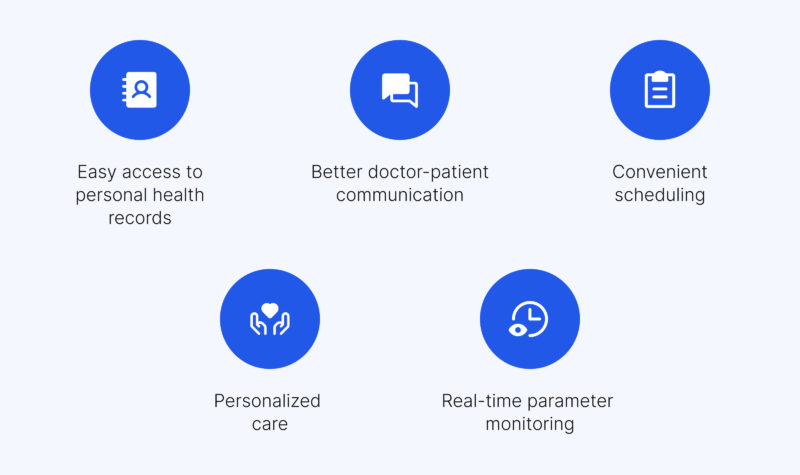
How will digital transformation in medicine help patients?
Patient portals, whether developed as standalone systems or integrated into EHRs, provide digitalization of health records, enable easy access to health information, including diagnostic test results, drug refills, treatment history, health insurance information, and more.
Advanced tools allow patients and doctors to communicate with each other via dedicated portals so that patients can request drug refills, ask questions related to their health, or schedule an appointment.
With digital tools, patients can choose the most convenient date for appointments and plan the time ahead.
By analyzing patients’ health conditions and the medications they are taking through dedicated analysis tools, physicians can prescribe personalized treatments tailored to particular patients.
With modern devices (e.g., watches, bands, ECG monitors, biosensors, blood pressure monitors, etc.), patients can monitor their parameters in real time. These devices can sync information with health apps and send data to emergency services that can provide urgent care if necessary.
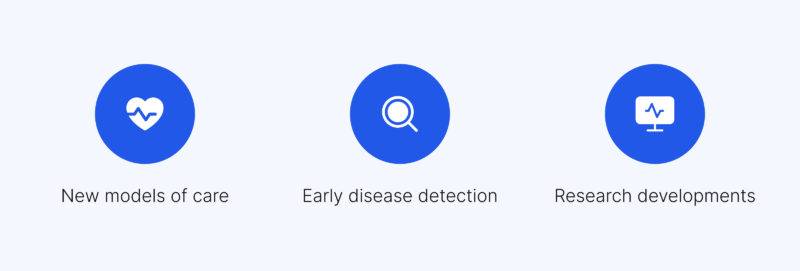
Healthcare business transformation
The accelerated pace of digital transformation has modified traditional healthcare by creating new care models. As a result, patients have become increasingly engaged in the care delivery process. Modern technologies give them more control over their health and improve health outcomes.
Furthermore, new technologies allow doctors to treat patients that are miles apart from each other. Such a possibility helps solve staffing shortages in small towns.
There are a number of diseases where early detection is essential for favorable outcomes. With advanced technologies, doctors can identify dangerous pathologies early in their development, even when patients feel good and don’t have any symptoms. This lifesaving capability is extremely relevant in relation to diseases such as cancer.
State-of-the-art technologies empower experts to predict viruses’ evolution and genetically linked pathologies, accelerate the discovery and implementation of vaccines, and find cures for diseases.
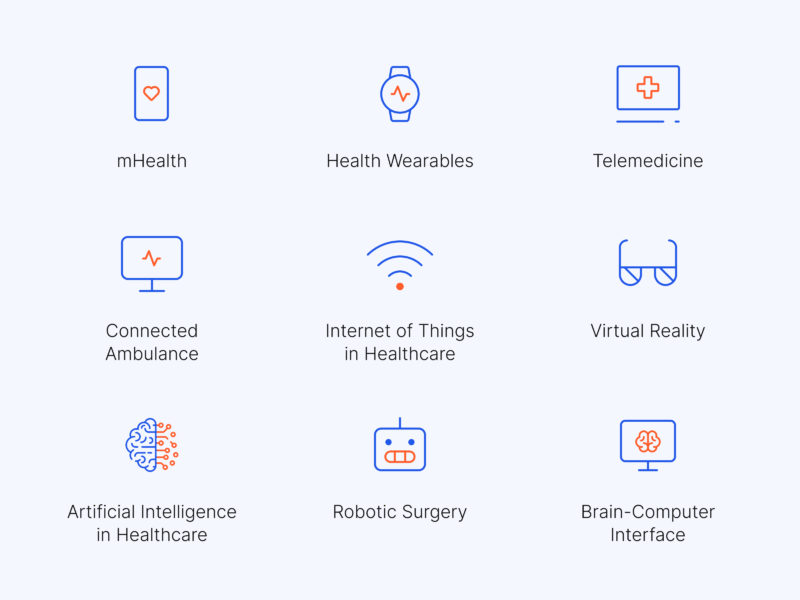
Top 9 Digital Transformation trends in Healthcare for 2023
Next-generation technologies, increased attention to personal health, and scientific research and discoveries define the trends in the healthcare industry. Among them, we can distinguish several main directions that will govern the healthcare of tomorrow. Each of the healthcare digital transformation trends is focused on improving patients’ lives and facilitating doctors’ work.
With the mass use of smartphones and the omnipresent Internet, mHealth apps are becoming more widespread. Today, the most popular are those that help lead a healthy lifestyle and encourage adherence to healthy habits. There are also patient-oriented services that allow people to quickly find the doctors they need and make an appointment, as well as intelligent chatbots for gathering patients’ medical history and searching for recommendations.
Wearable biosensor devices can obtain and monitor health data in real time. Biosensors measure individual health metrics (e.g., heart rate, oxygen carried in the blood, sugar level, blood pressure, etc.). They are especially important for patients with chronic diseases who must constantly monitor several physiological parameters at the same time. The devices can send health information to a doctor and even call an ambulance if needed.
Furthermore, smart watches, wristbands, and other similar devices are in demand among athletes and those who lead an active lifestyle. These wearables can track the duration and type of an activity, as well as metrics such as distance and calories burnt.
With IT technologies, healthcare professionals are able not only to examine patients remotely, but also provide consultations, collect medical history, request and send information about the course of diseases, and prescribe treatments. The main advantages of telemedicine are convenience, time savings, and safety. In many cases, there is no more need to waste time driving to the hospital or waiting for an appointment. In addition, online consultations eliminate the risk of catching a disease from other patients.
This is an advanced system that uses 5G technology to enable communication between paramedics and doctors. On the way to the hospital, the ambulance team can start taking measures to save the patient under a doctor’s expert guidance. The hospital staff, in turn, receives the relevant information in real time so that when the patient arrives, clinicians can provide the necessary procedures without wasting precious time.
The Internet of Things, or, as it’s called in healthcare, the Internet of Medical Things (IoMT), is one of the hottest trends in the IoT era. The IoMT helps medical staff remotely monitor patients’ condition, enhances medical procedures, controls the environmental conditions in the hospital, and performs many other functions to facilitate internal processes and assist healthcare providers in their work. In other words, IoMT allows creating smart hospitals.
IoT is the future of medicine. Indeed, IoT solutions have already been actively implemented in cutting-edge hospitals around the world. Studies predict that the number will increase significantly: by 2026, IoMT devices will be used in more than 7.4 million hospitals worldwide.
Virtual reality (VR) is much more than a kind of entertainment. It is a next-generation technology that revolutionizes industries, including healthcare. Today, VR technologies are already used in medicine to help patients and doctors achieve better treatments and outcomes.
Surgeons can virtually view a patient’s organs and practice before operation to be better prepared for a real intervention. Researchers say that such training improves overall surgical performance by 230% compared to traditional methods.
According to studies, VR technologies can reduce pain by 24% and more. VR immersion allows the patient’s brain to switch from pain and anxiety to the journey through a virtual world.
In addition, with VR, a physician or student can delve into the patient’s condition to thoroughly understand what they are going through. For instance, VR can give a valuable clue to the idea of what age-related illnesses are like, improving empathy toward such patients.
In fact, the potential of VR hasn’t yet been fully explored. Given the great possibilities that virtual reality opens up, this technology is destined to find widespread use among physicians in the future.
AI is one of the most promising technologies in medicine. Currently, AI provides several services:
Robotic assistants are one up-and-coming trend in the development of AI in medicine. Today, computer assistants already work alongside live nurses in some hospitals. Virtual nurses provide advice, guidance, or other health-related information, and they are available 24/7 to answer any questions in real time.
In recent years, more and more robots have performed successful operations on living beings. Nevertheless, today, their role is to assist rather than replace surgeons.
The main advantages of robotic surgery can be described with the word “less”: less blood loss, less tissue damage, less need for donor blood transfusions, and less postoperative pain. Operations performed with robot surgeons are minimally invasive due to the small size of incisions.
During robot-assisted surgery, doctors don’t stand on their feet but sit in a chair, controlling the robot arms; as a result, there is a lower chance of error caused by fatigue. Special high-resolution cameras enable surgeons to view the surgical area in detail, make precise incisions, and put in neat stitches.
Moreover, the risk of infection is close to zero because sterile manipulators rather than the surgeon’s hands come into contact with the patient’s body. As they are highly functional and precise, robots are excellent assistants in long and complex surgeries.
Brain-computer interfaces (BCIs) are used both in the treatment of neurodegenerative and psychiatric diseases and in neurorehabilitation. BCIs assist in the recovery of vision, hearing, motor skills, speech ability, and other cognitive functions.
For example, when the link between the brain and the limbs is broken by injury or disease, the physical computer comes to the rescue. Using special sensors, the computer detects and processes the electrical signals of the brain and transforms them into commands for a mind-controlled prosthesis. Thus, fully paralyzed people can move their limbs with the “power of thought.”
Despite their enormous potential, BCIs are not flawless. As the brain itself has not been fully studied, there is a risk of causing side effects when interfering with its work. In addition, BCIs create complex ethical issues.
Even so, BCIs represent one of the flagship areas of modern biological research. Difficulties are inevitable on the path toward technological developments. However, the need for – and benefits of – new, first-rate solutions to improve patients’ quality of life outweighs their potential negative consequences.
Everything has drawbacks, and the digital transformation is no exception. All health clinics, from small to large, must overcome certain difficulties when seeking to become more competitive. Let’s have a look at the obstacles that may slow down the total digital health transformation.
Medical software development must always comply with many strict rules. As these regulations are very numerous, the development team should study all the relevant requirements that the system must meet before starting to build the software.
While the relevant regulations differ from country to country, there are some common laws. In the EU, for instance, it is the GDPR (General Data Protection Regulation) while in the US the most crucial regulations are HL7 (Health Level Seven) and HIPAA (Health Insurance Portability and Accountability Act).
All these rules and medical software standards impose certain obligations on developers: they must create limited data sets, anonymize data, and set role-based access in order to protect the sensitive data and avoid the substitution of information, among other requirements.
Many of the rules with which healthcare systems must comply are designed to ensure data privacy and security. However, cybercriminals are not idle; every day, they come up with new ways to bypass the protection systems built by engineers. Therefore, healthcare organizations should pay particular attention to the protection of patients’ personal data and should implement security mechanisms to an even greater extent than required by regulations (HIPAA, GDPR, etc.).
While there is no universal recipe for an ideal information security system, there is one thing that the heads of any medical organization must do: find a person who will deal with this issue. This person must keep up with regulatory updates, keep abreast of new security products, analyze the company’s protection level, and take measures to enhance protection. Sometimes one employee is enough, but other times there is a need to hire several highly qualified experts. This leads to another challenge: the shortage of talent.
To succeed in the digital transformation, first and foremost, there must be a top-notch team skilled in cybersecurity, application architecture, software integrations, and data analytics. These are exactly the kind of specialists that are in deficit today. Outsourcing can solve this problem; leaders can turn to reliable and experienced software development vendors to reinforce their in-house teams.
At EffectiveSoft, we know how essential it is to comply with all the rules and regulations, follow and implement the latest healthcare trends, and provide secure software. Our top-notch team can handle projects of any complexity. Drop us a line to learn more about how we can help you.
People find it very difficult to get out of their so-called comfort zone. The same applies to business. Some might ask, “Why change something that works?” However, it is precisely this logic that blocks digital progress. Legacy systems are often slow and inflexible. For this reason, it is very difficult to integrate new technologies and ensure data security.
Implementing new digital solutions is an expensive process that requires reasonable investments. As a result, it is also a long process. Rarely can anyone completely transform an organization in a heartbeat. Therefore, the best option is to gradually introduce digital innovations in healthcare, starting with the most critical areas, while simultaneously preparing the staff for the new business model based on advanced technologies.
The market offers many opportunities. If an organization is short of funds, leaders can turn to off-the-shelf software solutions, but this option has its own pitfalls: ready-made systems are often more expensive in the long-term and may lack the functions vital for the organization.
Today, it’s no longer possible to talk about development and digital transformation separately. They now go hand in hand, as growth strategy automatically involves the introduction of innovative technologies into business workflows in most cases.
If you are ready to take advantage of a modern, more effective, and automated health service system, contact us to find out how your organization can start leveraging the benefits of digital transformation in healthcare. We have considerable expertise in providing healthcare software development services.
Our team would love to hear from you.
Fill out the form to receive a consultation and explore how we can assist you and your business.
What happens next?